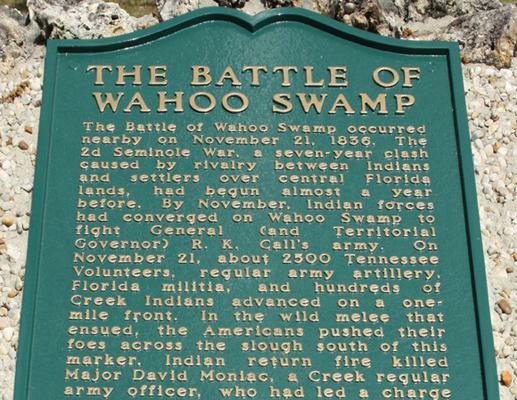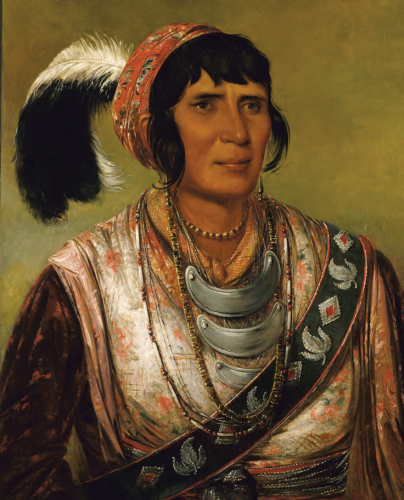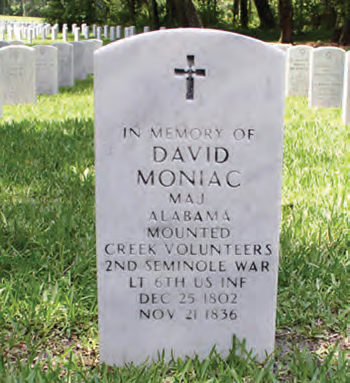David Moniac (1802–1836), a Creek Indian, entered the United States Military Academy in 1817 only a decade and a half after the institution’s founding. Although not the first American Indian to attend West Point, he appears to be the first to have graduated. As a commissioned officer, he was killed in action during the Second Seminole War. From the U.S. Army standpoint, he died a hero, but his brief career shows the ambiguity of many Native lives during a time of Indian removal and resistance.
Moniac entered West Point only three years after the conclusion of the bloody Creek War, also known as the Red Stick War, of 1813–1814. The U.S. Army, with American Indian allies including Lower Town Creeks, fought against Upper Town Creeks led by Moniac’s uncle, William Weatherford, Chief Red Eagle. Even before General Andrew Jackson’s final victory at the Battle of Horseshoe Bend, the Creek Country in today’s Alabama and Georgia had been laid waste. In the Treaty of Fort Jackson in March 1814, the Creeks were forced to cede more than 22-million acres in Alabama and southern Georgia.
Moniac’s life demonstrates the difficulty of generalizing about the Native experience. Creek identity was multidimensional, dependent mostly on which town happened to be the individual Creek’s birthplace, or which Scottish trader happened to gain economic or kinship ties. Just as self-interest motivated American colonists in the Revolution to become rebels or loyalists, Creeks chose different sides throughout their history. As late as the Civil War, they once again found themselves fighting each other in a bloody conflict.
The Creek youngster entered West Point in 1817 with more complex motives than a burning desire for a lifelong military career. His first priority appears to have been self-improvement, taking advantage of a free education. He clearly saw the advantage of this training as well as a government stipend paid to cadets at the time. In some ways, he was no different from many other cadets. Patriotic military service often took a back seat to economic realities after the War of 1812; 30 percent of Moniac’s Class of 1822 left military service for civilian careers in the decade after graduation.
The Path To The Academy
David Moniac, whose name also appears as MacNac, Manak or Monack, was born around Christmas day in 1802 at Pinchong Creek, Montgomery County, Mississippi Territory. His father, Samuel Takkes-Hadjo Moniac, was descended from the son of a Creek woman and her Euroamerican husband, Dixon Moniac, who had been in the region since 1756. His mother, Elizabeth Weatherford, was the sister of Red Eagle from the Upper Creek town of Tuskegee. At the time of Moniac’s birth, his parents were living in Tuskegee, at the forks of the Coosa and Tallapoosa rivers, not far from the battlefield of Horseshoe Bend.
The Creeks, including David’s own relatives, had intermarried with Euroamericans, mostly Scots traders. Although these whites prospered by this arrangement, in some ways, the Creeks also benefitted. Clan and village leaders recognized the importance of connections with the deerskin traders and interpreters in their midst. These whites frequently married women of the prestigious Creek Wind Clan, such as David’s mother Elizabeth, and these marital ties helped advance trans-Atlantic trade. Consequently, many prosperous Creeks spoke English, herded cattle and even owned slaves.
Creeks gained control of non-Indian trade practices. Until the devastation brought on by the Red Stick War, intermarriage with traders allowed the Creeks to receive a steady flow of trade goods and fair prices for their skins. Sam Moniac, David’s father, benefitted from these connections. He prospered before the war as a rancher and slave owner, but also as the proprietor of a tavern on the famous Federal Road, the major commercial route that cut through the heart of Creek Country.
Moniac’s path to West Point began well before the Red Stick War. In 1790, Chief Alexander McGillivray, David Moniac’s grand-uncle, negotiated a treaty with federal officials with a secret provision for the education of four Creek youths by the United States. Young Moniac attempted to take advantage of the treaty codicil by applying formally to West Point.
Moniac’s academic preparation was limited but comparable to other entering cadets. At the time, the Military Academy had minimal academic admission standards, even taking boys as young as 12 or 13! Despite his youth, Moniac, at several months short of 15, was not the youngest cadet in his class. He was older than or approximately the same age as 13 of his classmates. Moniac had not had formal schooling, having been tutored privately. But his prominent Creek lineage, his exposure to the customs, ideas and religious beliefs of his white relatives, and the growing presence of Scot traders and Moravian missionaries all contributed to his education.
On March 1, 1816, in one of Moniac’s references, Colonel Gilbert Russell wrote that the boy’s father was one of the friendly Creeks in the Red Stick War. Despite Moniac’s age, only 13 at the time, the colonel insisted that he was an industrious lad, more mature than boys of his age and that, as the only tribal member put forth to attend West Point, his application had the support of the Creek Nation. Russell then stated that Moniac’s admission would further the national interest by strengthening ties with the Creeks. Although this strong recommendation did not lead to the Creek boy’s immediate appointment, the Moniacs and their supporters continued to lobby for his admission. After a second effort he was accepted to the school in September 1817, at the age of 14 years and eight months.
A School In Disarray
When Moniac arrived at West Point in 1817, the academy was in crisis. Little had been done to improve training. Despite new barracks, a mess building and an instructional academy, the library was inadequate; cadet discipline was undermined by administrative favoritism; faculty morale was low and a comprehensive and rigorous curriculum was nonexistent. The school did have several distinguished faculty, however, notably Claude Crozet, assistant professor of engineering. Crozet was a graduate of the French Ecole Polytechnique, and had earlier served in Napoleon’s army. He later went on to head the Virginia Military Institute. The brilliant Crozet, who barely spoke English on his arrival, soon found that even if the cadets understood his limited English, his level of instruction was over most of their heads. Since, in the age of Napoleon, many of the military texts were written in French, all cadets at West Point were required to take courses and demonstrate proficiency in the language. Unfortunately for Moniac, this language requirement was his major stumbling block.
Cadets were exposed to other classics, such as Emmerich de Vattel’s The Law of Nations and Jedidiah Morse’s American Geography. Morse’s work was a compendium of knowledge: anthropology, astronomy, biology, geology, geography, history and philosophy, but it had direct relevance to the Creek people. Through his crystal ball and religious faith, Morse, a Congregational minister, predicted America’s continental destiny, namely the annexation of Florida, the Mexican War and the Oregon settlement. He taught that predestination, geographical and religious, ensured the success of the rising American empire. To Morse, whose works were widely read, the Indians had to be removed and assimilated as quickly as possible for their own good. His view was obviously not lost on a Creek cadet studying his book at West Point.
Of the 119 students who entered with Moniac in 1817, only 40 were graduated in 1822. But no matter their level of academic ability, cadets faced challenges beyond coursework. Sheer existence at West Point in these years was difficult. The academy was largely isolated. Except for the occasional riverboat from New York City, its inaccessible location in the often fog-covered Hudson Highlands and the poor roads of the time made overland travel difficult, especially in the winter months. The only diversion for the cadets was an illicit visit to the North (Gridley’s) Tavern just outside the post’s gate. Moreover, cadet accommodations were Spartan at best. The barracks had no running water or central heating. Cadets had to haul buckets from a well and bring firewood from the wood yard near the barracks. Because of the constant threat of fires, a water bucket and a tinderbox were required in the barracks, which otherwise contained little furniture. Cadets had to buy all furnishings from their $18-a-month federal stipend.
Just as Moniac arrived in 1817, a new superintendent, Sylvanus Thayer, took over the reins of administration at the United States Military Academy. Thayer demanded a higher level of academic performance. To Thayer, the primary mission was to train engineers or soldiers, and all other instruction was irrelevant. To contend with the lax admission standards that required proficiency only in reading, grammar and arithmetic, the new superintendent began a system of tracking cadets; they could be transferred to more advanced or slower sections according to their oral and written performances. Much weight for class evaluation was placed on daily oral recitation at the blackboard. Certain subjects, especially mathematics, counted most for their final academic standing.
Moniac’s Performance
Cadet Moniac obeyed nearly all of the rules of the academy. His overall rank in conduct was 15, placing him in the top 40 percent of his class in this category. At a time when Thayer instilled a stern hand and students were subject to military courts-martial, Moniac’s record was impressive. He received very few demerits at a time when 200 per year led to automatic dismissal from the academy. Moniac was cited 21 times for alleged delinquencies, none of which were alcohol-related or involved fights with his classmates. Ten of the infractions dealt with his cutting or talking during study hall. Twice he was written up for failing to sign his name when he was paid his monthly stipend. Twice he was reprimanded for staying in bed after morning roll call, and on another occasion he was cited for not being in bed before curfew. He was also delinquent for cutting two classes in tactics and once for missing military drill. On two occasions he neglected to hail the officer of the day, perhaps the most egregious of his offenses while a cadet. He also appears to have served as mentor for at least one plebe just before his departure from West Point.
Moniac’s overall record in his coursework must be read with care. Even though he was graduated 39 out of 40 in overall rank, two-thirds of the classmates who entered with him in 1817 had dropped out by 1822. The Creek cadet’s rank in the hierarchy is also somewhat ambiguous and hard to interpret. For example, in August 1820, he was appointed Fourth Sergeant of the second company of cadets. Later, in June 1821, he was promoted to First Sergeant, but after only a week, he stepped down from this appointment.
Reluctant Celebrity
In 1818, the Swedish government sent Baron Alex Klinkowstrom, a lieutenant colonel on its general staff, to study and report on the United States’ achievements in the decades after the American Revolution. In one of his reports, the baron contrasted the training of cadets at West Point with the military schools of Europe. He pointed out that the United States Military Academy demanded more mathematics than its European counterparts, but less training in equestrian skills and less foreign language proficiency.
Klinkowstrom was taken to a class in mathematics where he witnessed what he considered an extraordinary scene. An American Indian student was demonstrating and analyzing the relation between cosine, sine and radius. The Indian did this by means of a rather involved calculation; the instructor repeatedly interrupted to refer him to other theories which might have some relation to the problem. The Swedish visitor added: “This youth is a descendant of the Creek nation; his name is Moniac. In all probability he does not intend to go into the service of the United States, but to return to his people in order to give them the benefit of his achieved knowledge. He can also check the American surveyors in case the United States wishes to buy more land from the Creek territory.” Perhaps contrasting this scene with the Swedish government’s policies of the time toward the Sami, the indigenous peoples of Scandinavia, the baron praised American efforts to uplift the Indians.
Moniac also attracted attention outside of the Academy. In August 1821, more than 200 cadets marched from West Point to Boston. When they arrived in the city, they performed their drills with precision, and their marching band played rousing martial music. One observer, Josiah Quincy, accompanied his famous relative, the former President John Adams, to the pageantry and wrote: “Here was a military corps, splendidly equipped and composed of the most promising young men in the country. The training at West Point was then far superior to any given at the colleges, and these young gentlemen were known to be subjected to an intellectual discipline which was quite as severe as their physical drill.” One of those young men was David Moniac.
Former President Adams invited the cadets to his home in nearby Quincy. There, the corps once again went through their exercises and musical performances. The venerable Founding Father then addressed the troops. The Commandant of Cadets, one Major William Worth, tried to induce Cadet Moniac to meet with the President, but Moniac refused. Worth informed the President that the cadet was too bashful.
Moniac was evidently embarrassed at becoming a center of attention. Celebrity was not a value taught in Creek Country. He had been inculcated with a group, rather than an individual, ethic as a child growing up in Tuskegee.
As a West Point cadet, Moniac had apparently become a curiosity. Major Worth added revealingly in his apology to President Adams: “I have myself been taken for the Indian all along the road. People would point to me, and say, ‘Look there! There’s the Indian!’” Despite Moniac’s education in the white world of West Point and his long absence from Creek Country, he was still the Indian in the ranks, subjected to being gawked at for being the exception, the “civilized Red Man” in the bastion of American military power. He still saw himself in a foreign land, far away from his homeland, his Creek town, his kin, his people.
In April 1822, his last year at West Point, Moniac received an impassioned plea from home to return as quickly as possible because of his alcoholic father’s inability to manage his family’s financial affairs. Moniac, nevertheless, stayed on for his graduation in June. His graduating class of 40 included five future generals in the United States army, two generals in the New Jersey militia, two high-ranking officers in the Confederate army, three college presidents and at least five civil engineers or chief operating officers of railroads. At least 10 of the 40 graduates resigned their commissions or died before the outbreak of the Second Seminole War in 1835. Seventeen of the cadets served on the frontier, including three in Creek Country, 10 in the Second Seminole War and one in the Cherokee removal. Three in the Class of 1822 died during the Second Seminole War, including Moniac himself.
Civilian Life, And War
After graduation, Moniac received a commission as second lieutenant in the 6th United States Infantry in early July. Although he accepted the commission that he had worked so long to achieve, he subsequently received a leave of absence and resigned from active duty on Dec. 31, 1822. He went back to Alabama, where he rebuilt the family’s financial prospects by establishing a plantation in Baldwin County, Ala., where he raised cotton and bred race horses. He later married Mary Powell, the cousin of Osceola, the Creek-born leader of the Seminoles.
But Moniac’s civilian life ended when the Second Seminole War erupted in 1835. He re-enlisted and received a military commission the next year. Major Moniac was killed in action at the Battle of Wahoo Swamp on Nov. 26, 1836. There, his Creek Indian regiment, part of General Richard Call’s 2,500-man force composed of United States Army regulars and Florida and Tennessee militia, advanced on a camp of approximately 600 Seminoles and allied African Seminoles. With the threat of removal from their Florida homeland and the return of their allied African Seminoles to slavery in Georgia and Alabama, the Seminole forces led by Osuchee (Cooper) and Yaholooche (Cloud) successfully resisted the onslaught. Fearing that his heavily laden army would get stranded in the mud of a stream that separated the opposing forces, Call refused to pursue the Seminoles when they pulled back and withdrew from the battle. Moniac himself was shot while trying to find a ford across the stream.
Today David Moniac is honored by his descendants at the Poarch Creek community in Alabama and elsewhere in the South. In the Town of Bushnell, Sumter County, the State of Florida has placed a historical marker emphasizing Moniac’s bravery at the Battle of Wahoo Swamp. The United States Army has also named its reserve center in Montgomery, Ala., after him.




